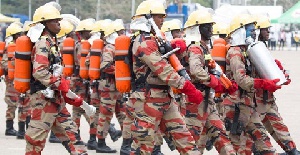 Officers of the Ghana National Fire Service
Officers of the Ghana National Fire Service
A total of 391 fire cases were recorded in the Northern Region in the year 2022, resulting in damages to property estimated at GH¢7, 426,219.2.
The figure was an increase over the cases recorded in the year 2021, which stood at 367 fire cases resulting in damages to property estimated at GH¢ 4,025,092.00.
This was contained in a statement issued by the Northern Regional Command of the Ghana National Fire Service (GNFS) signed by Assistant Divisional Officer Grade two (ADO II) Baba Hudu, Northern Regional Public Relations Officer of the GNFS, and copied to the Ghana News Agency in Tamale on Tuesday.
The statement said items worth GH¢ 8,718,786 were saved as against GH¢ 8,206,055 for the same period in 2021 representing an increase of 6.25 per cent.
It said while no life was lost through the fire cases, 87 injuries were recorded while 12 lives were lost through 10 road traffic collision incidents in 2022 as against 17 lives lost through 14 incidents for the same period in 2021 representing a decrease of 5.88%.
It said the months of January and December recorded the highest incidents of 81 and 76 fire cases representing 20.72% and 19.44% respectively, which were caused by 203 domestic, 53 commercials, 42 electrical and 41 bushfire cases while the rest were vehicular and institutional cases.
The statement said the region, over the period, had experienced a new trend of fire that ravaged uncompleted buildings, especially at new settlements.
It said the Tamale Metro Fire Station recorded 94 fire cases, which represented 24% of the total fires for 2022, followed by the 87 recorded by the Regional Headquarters Sub-Station, which represented 22.25% adding the Sagnarigu and Tamale Teaching Hospital Fire Stations had 69 and 61 cases representing 17.64% and 15.6% respectively.
It said the Yendi, Savelugu and Bimbilla Stations recorded 44, 28 and eight cases representing 11.25%, 7.2% and 2%, in that order.
The statement called on the public to make positive changes in their attitudes towards the use of naked lights, gas cooking apparatuses, electricity, and electrical appliances to forestall the occurrences of preventable fires.
It also advised the public to avoid pranking the GNFS on its emergency numbers to enable it to respond timeously to real emergencies to save more lives and property.
It assured that the GNFS was poised to work to reduce the rate of fires through its continuous and intensified public safety campaign dubbed: “1 Fireman to educate 100 people (1:100)” by the end of the first quarter.